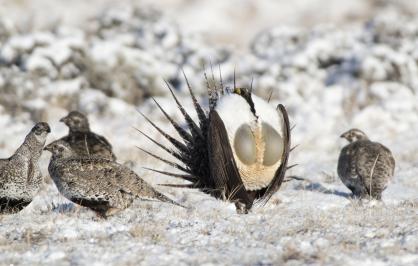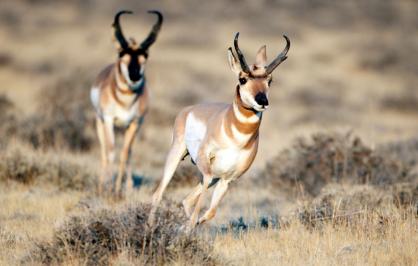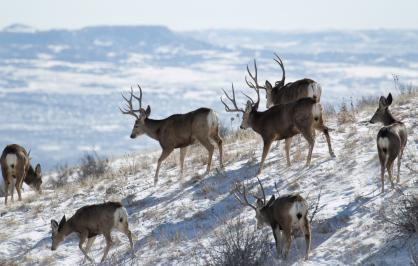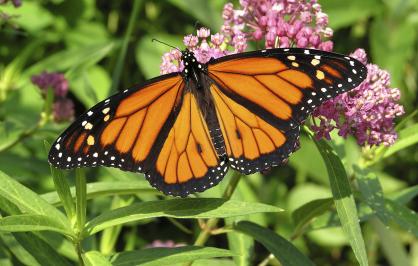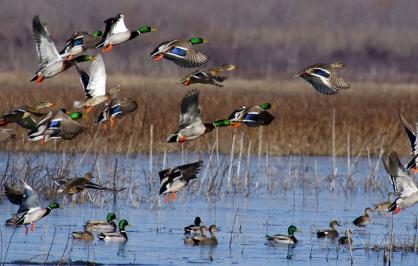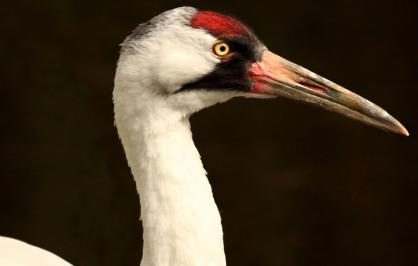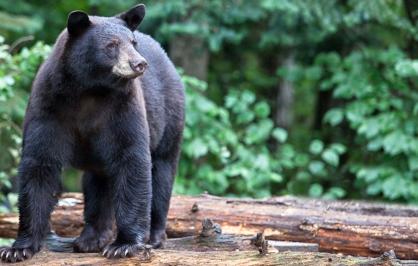NFWF’s Atlantic Flyway Shorebird Initiative invests in projects that benefit birds like this whimbrel, which undertake some of the longest migrations of any animals on earth.

Protecting wildlife migration routes
2020 Conservation Highlights
The yearly migrations of wildlife across our nation’s vast landscapes represent a fundamental and fascinating part of American life.
Who could imagine an autumn without geese and ducks flying south in their distinctive V formations? What kind of spring would it be if songbirds and hummingbirds failed to make an appearance at our bird feeders and in our parks? How dull would it be, sitting on a beach in the summertime without lively little plovers and sandpipers to entertain us at the water’s edge?

Many of the most iconic and beloved wildlife species in the United States have become so deeply rooted in our culture precisely because they migrate. We mark the seasons by their arrival and departure, from baby sea turtles hatching along Florida’s beaches to humpback whales giving birth off Hawaii. We marvel at their journeys, from the 2,500-mile, nonstop flight of whimbrels to the mysterious, multi-generational migration of monarch butterflies. We depend on these yearly bounties for subsistence, prosperity and quality of life, from life-sustaining harvests of salmon in the Pacific Northwest and Alaska to recreational hunting of waterfowl in Arkansas and elk, moose and deer in the Rocky Mountains.


Protecting the ability of these animals to migrate, both in the immediate future and for generations to come, represents a major focus of our investments. The Foundation and its network of funding partners and on-the-ground implementers act quickly to address direct threats to wildlife on the move. We also protect migratory routes facing long-term threats from development and climate change.
NFWF leads the way in protecting migrations across our nation by putting conservation dollars to work wherever they generate the greatest benefits to migrating wildlife, from state and federal lands to private farms and ranches, suburban neighborhoods, remote islands and major metropolitan areas.
Big game migrations
NFWF helps protect and improve migration corridors in Western states for pronghorn, elk and mule deer. Many of the migration-related grants awarded by NFWF in 2020 focused on fencing modifications, dangerous road crossings and wintering grounds for these large ungulates. Examples of our 2020 grant-making include:
The Colorado Department of Transportation won a $480,400 grant to install fencing that will guide mule deer and elk to an underpass being constructed in the northwest part of the state, as well as a $267,900 grant to reduce wildlife-vehicle collisions at a crossing near Salida.
NFWF awarded nearly $310,000 to the Mule Deer Foundation in Idaho to improve 24 miles of fencing, protect habitat, and improve management on 255,000 acres to benefit mule deer, elk and resident species.
Watch: Across the West, NFWF is working with ranchers, federal and state partners, and other non-profit organizations to support conservation on working lands.
The New Mexico Association of Conservation Districts will leverage a $250,000 grant from NFWF to restore grassland habitat and modify 40 miles of fencing. Such projects are particularly important for pronghorn, which can’t jump over fences — they must crawl underneath, risking injury and entrapment.
The Wyoming Game and Fish Department was awarded a grant of $249,000 to restore native grassland and sagebrush habitat and improve 19 miles of fencing in the wintering grounds of mule deer completing an arduous, 150-mile migration between summer and winter ranges.
Bird migrations
Many of the large-scale conservation projects NFWF supported in 2020 benefited migratory birds of all shapes and sizes, from tiny hummingbirds to giant cranes. These projects focused on improving habitats along North America’s flyways for waterfowl, songbirds and shorebirds. Examples of our 2020 grant-making include:
Major grants awarded, in partnership with the Walton Family Foundation, to projects in the Mississippi Alluvial Valley, including a $654,000 grant to the Mississippi River Trust and $696,000 to The Nature Conservancy, will restore and protect forested wetlands and floodplains vital to migrating ducks, geese and songbirds.
Two grants to the American Littoral Society in New Jersey, one for $500,000 and another for $487,000, will stabilize beaches where red knots, plovers and other shorebirds fuel up on horseshoe crab eggs during migration.
In Colorado, Ducks Unlimited will leverage a $273,000 grant to restore wetland habitats along the South Platte River necessary to sustain populations of mallards, pintails and many other types of waterfowl.
A $85,000 grant to the University of South Carolina will help protect an island near Charleston that contains the largest known nocturnal roost for northward migrating whimbrel.
In Hawaii, Pacific Rim Conservation will use a $45,000 grant to deploy thermal imaging drones to locate breeding colonies of Newell’s shearwaters and Hawaiian petrels.
Salmon and other migrating fish
Anadromous fish such as salmon and river herring migrate at different points in their life cycles between the ocean and freshwater flows. These fish travel hundreds or even thousands of miles every year, sending a pulse of life and nutrients through the nation’s major watersheds. Examples of our 2020 grant-making include:
A $294,000 grant to the Idaho Department of Water Resources will enable scientists and land managers to implement voluntary water transactions in the Upper Salmon River basin to ensure that Chinook salmon and steelhead can access spawning grounds.
Watch: A village in Maine restored their 200-year-old fish ladder for river herring, returning centuries of tradition built around their migration.
Leveraging a $101,000 grant from NFWF, Trout Unlimited will perform a critical analysis on water flow in Alaska’s Eklutna River to benefit not only migrating salmon, but also the people of the Eklutna tribe.
NFWF also awarded a number of grants to improve migration routes for alewives, American eels and Atlantic salmon in Maine and Connecticut, including $172,000 to the Connecticut Fund for the Environment and $143,000 to the Aspetuck Land Trust.
Monarch butterflies and other pollinators
In one of the world’s most incredible annual migrations, monarch butterflies flutter their way from the mountains of central Mexico throughout most of the United States, then back again. Completing this journey requires up to five generations of butterflies — scientists are still not sure how the final generation finds its way back to the same mountains in Mexico. NFWF and its partners are working to halt declines in monarch numbers, due in large part to the loss of native milkweed, upon which monarch caterpillars feed. Examples of our 2020 grant-making include:
In Texas, the American Bird Conservancy will use a $75,000 grant to work with private landowners to restore 500 acres of degraded habitat within the core area of the monarch’s migratory route.
Watch: NFWF's Monarch Butterfly and Pollinators Conservation Fund advances the conservation of the monarch butterfly and other at-risk native insect pollinators.
A $75,000 grant to the Pollinator Partnership will support efforts in states across the Midwest to improve habitats and expand a native seed collection program to benefit monarch butterflies other declining pollinator species.
In California, a $75,000 grant to the Xerces Society for Invertebrate Conservation will enhance the quality of critical overwintering habitat for the western population of monarch butterflies.
Want to learn more? Explore an interactive map of where we work.

Next Highlight: Working With the Private Sector...
We work with our nation’s leading corporations to help advance their philanthropic missions.
Learn More





















